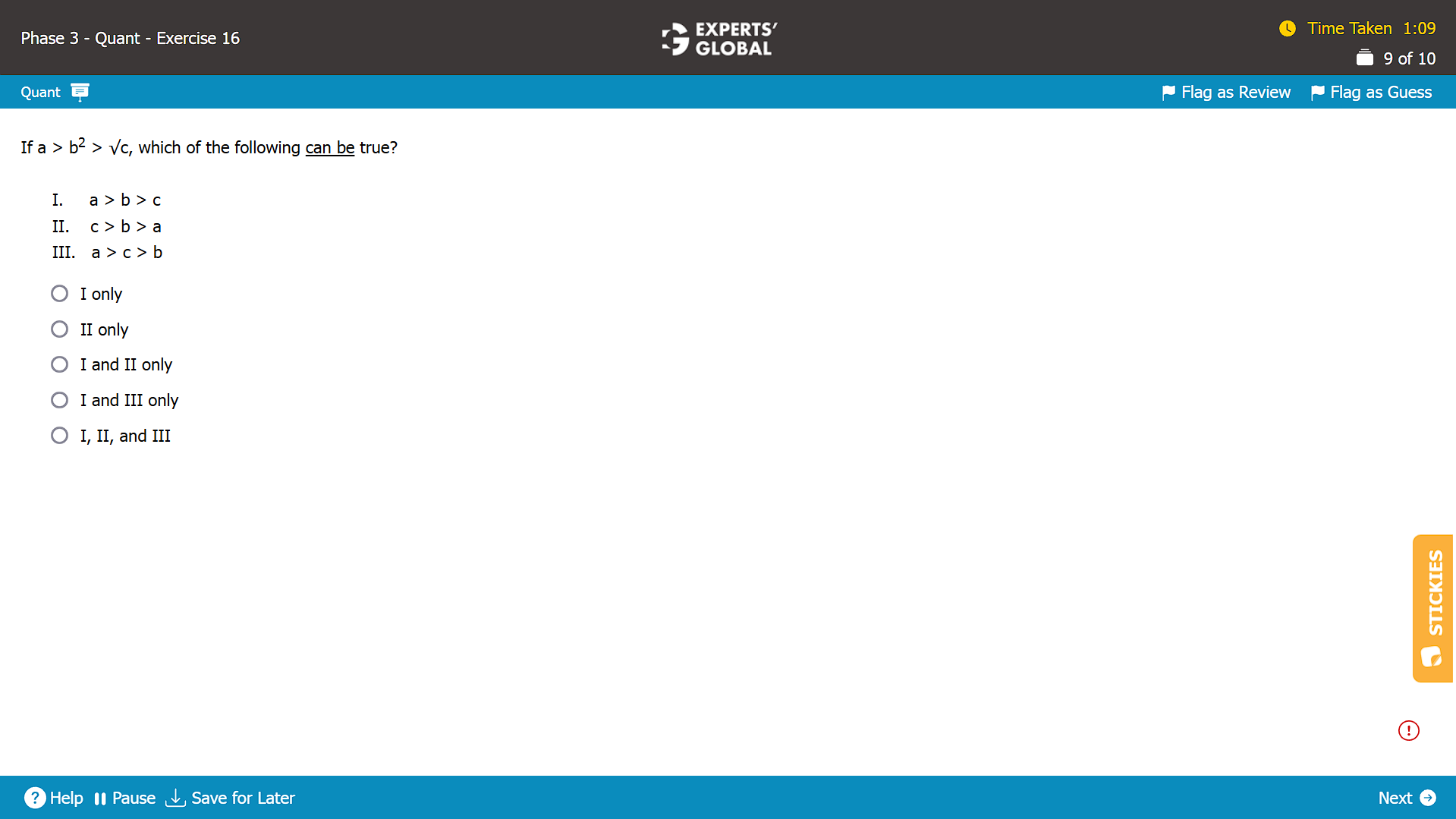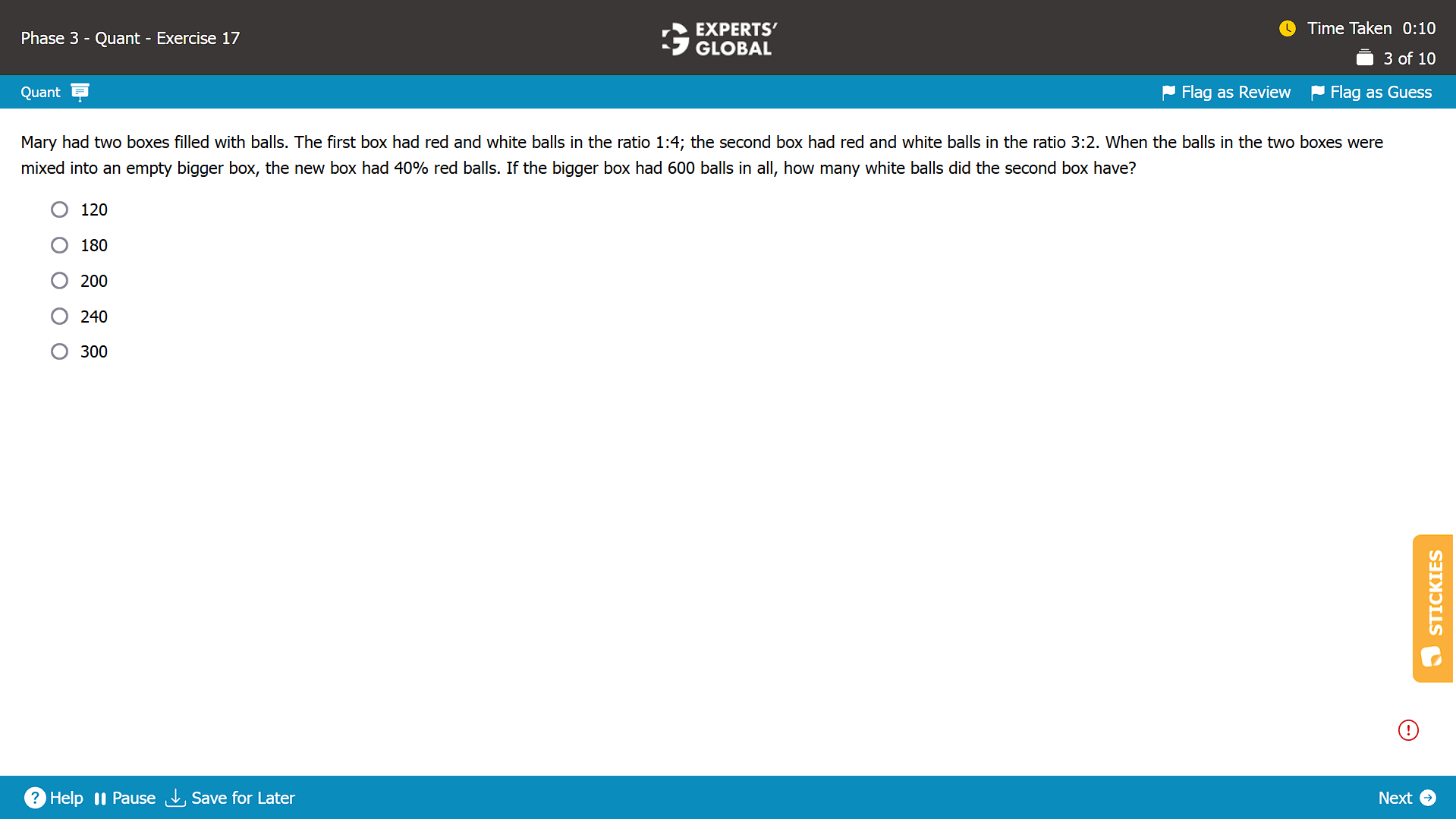Invest 30 seconds...
...for what may lead to a life altering association!
Help Line
- +91.8800.2828.00 (IND)
- 1030-1830 Hrs IST, Mon-Sat
- support@expertsglobal.com
...for what may lead to a life altering association!


Problem Solving is the only question type in the GMAT Quantitative section. Each question presents five answer choices, only one of which is correct. These questions test arithmetic, algebra, number properties, statistics, and combinatorics, focusing on logical application and efficient decision-making under time pressure.
Familiarize yourself with all question types on the GMAT by taking a free GMAT practice test
Problem Solving is the only question type in the Quantitative Reasoning section of the GMAT, making it essential for every test-taker to understand this format thoroughly for successful GMAT prep. These are standard multiple-choice math questions, each consisting of a question stem followed by five answer options, only one of which is correct. You are expected to arrive at the correct answer through logical deduction and necessary calculations. The questions test your ability to apply core mathematical concepts to real-world decision-making scenarios. You are not required to memorize advanced formulas, as the GMAT focuses on reasoning and quantitative judgment. Problem Solving questions may be direct or embedded in word problems and cover topics such as arithmetic, algebra, number properties, statistics, and combinatorics. This article offers a comprehensive and timeless guide to mastering them.

Correct Answer: D
Here are some key features of GMAT Problem Solving questions:
Although the GMAT does not require deep theoretical mathematics, it expects precision and fluency in a set of core topics. Here are the primary content areas tested in Problem Solving:
This includes:
Key algebraic concepts include:
These include:
Basic statistical concepts appear regularly:
You are tested on:
You do not need to memorize complex formulas for probability or combinatorics. Instead, focus on understanding how these concepts work.
Word problems present mathematical concepts through short, real-world scenarios. On the GMAT, these problems require you to extract relevant data, translate the information into mathematical expressions, and apply the right concepts to solve. They test your comprehension, reasoning, and ability to model quantitative situations. The correct approach is to read carefully, identify what is being asked, define variables systematically, and solve step by step while avoiding unnecessary calculations or assumptions.

Correct Answer: A
GMAT Problem Solving questions are known for being straightforward in appearance but tricky in execution. Here are some typical patterns you will encounter:
Some questions allow you to test answer choices by substitution. These are best approached by trying the middle value first and adjusting based on the result.
When equations are not easily solvable algebraically, working backwards from answer choices can save time and reduce errors. Know more about backsolving.
When exact values are not necessary, estimation becomes your best tool. Watch for answer options that are widely spaced, indicating that approximation is sufficient.
Many problems contain trap answers that result from common mistakes such as:
The GMAT often includes tempting wrong answers that represent the result of a small but common calculation error.
The preparation for Problem Solving questions on the GMAT Quantitative section can be divided into three well-defined stages, what we at Experts’ Global call: Understand, Practice, and Master. Each stage is vital for building the clarity, accuracy, and confidence needed to perform well under time pressure.
Begin your GMAT Quantitative preparation by developing a strong foundation in core math concepts. Focus on arithmetic, algebra, number properties, statistics, and combinatorics, as these are the key areas from which Problem Solving questions are drawn. A structured GMAT course that explains these concepts through practical, problem-based learning is ideal. Pay attention to how GMAT questions are framed and where students typically make mistakes. GMAT problems are less about applying memorized formulas and more about logical application and interpretation. During this stage, aim for clarity and accuracy over speed. Understand how traps are embedded in the answer choices, and train yourself to analyze the structure of each problem before attempting a solution.
Once the conceptual groundwork is in place, transition to focused practice. This stage is about solving questions in volume, with a sharp eye on speed and precision. Work through a wide range of problems from official GMAT resources and trusted private practice banks. After each set, review your solutions with care. Note whether your errors stem from conceptual gaps, careless mistakes, or a misreading of the question. Deep analysis of your missteps is crucial for real progress. As you become faster and more confident, begin to identify recurring question patterns and refine your approach. Revisit weak areas without hesitation. This phase is about refining your skill through repetition and reflection.
The final stage of preparation transforms your effort into exam-day readiness. Take high number of GMAT full-length mock tests under realistic conditions, ideally during the same time slot as your scheduled GMAT. This helps train your mental alertness to peak at the right time. Simulate the pressure of the exam by solving long sets of Problem Solving questions in a single sitting. Use your error log to review recurring issues and polish your understanding of frequently tested concepts. The goal in this stage is consistent performance and efficient time management across a full test. Reinforce shortcuts and strategies that save time, and practice staying composed under pressure.
By approaching Problem Solving preparation through these three structured stages, you will equip yourself to face the Quantitative section with control, clarity, and endurance. Problem Solving questions reward strategic thinking and composure. The more thoroughly you prepare, the more intuitive and accurate your responses will become under timed conditions.
Approach the test with clarity and focus. A steady mind leads to better decisions, especially under time pressure.
Do not experiment with new techniques on test day. Stick to the strategies that worked during your practice.
If a question takes too long, make an educated guess and move on. The Question Review & Edit feature lets you revisit and change up to three answered questions at the end of the section. Remember, you can score high even with a few mistakes, so do not get stuck on any one question. Stay sharp, stay strategic.
Do not waste mental energy judging how well you are doing. Stay present and focused on the current question.
Leaving questions unattempted carries a heavier penalty than getting them wrong. Always complete the section, even if you must guess the final few questions.
An efficient MBA admissions mentoring team can guide you through your GMAT preparation and applications journey. With timely planning, the mentors can help you stay focused, avoid common mistakes, and enhance your profile meaningfully. When you begin early with the right guidance, every step gains purpose and your entire MBA journey stands on stronger ground.
Problem Solving is not just a math exercise. It reflects how you think, how you decide under pressure, and how you manage resources such as time and attention. These are the very skills that business education and leadership roles demand. The GMAT does not reward rote knowledge. It rewards clarity of thought, attention to detail, and practical application of math. By focusing on building solid conceptual understanding and combining it with structured practice, you can significantly improve your Problem Solving performance. With consistent effort, the right mindset, and focused practice, you will find yourself approaching the GMAT Quantitative section with not only competence but also confidence.
Prepare efficiently with our end-to-end GMAT prep course and B-school admissions bundle